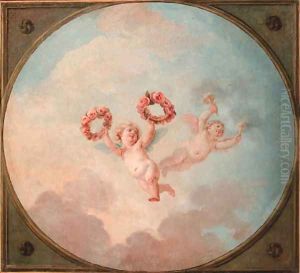Charles-Dominique-Joseph Eisen Paintings
Charles-Dominique-Joseph Eisen was an influential French painter and engraver born in 1720 in Valenciennes, at the time a part of the Spanish Netherlands (now in France). He is best known for his contributions to the Rococo movement, which was characterized by lightness, elegance, and an exuberant use of curving natural forms in ornamentation. Eisen's work often depicted whimsical scenes, filled with light-heartedness and playful characters, embodying the Rococo spirit of pleasure and entertainment. His father, Frans Eisen, was also a painter, from whom he likely received his initial training before moving to Paris to further his art education and career.
In Paris, Eisen became a student at the Royal Academy of Painting and Sculpture, and by 1748, he was received as a master. His talent quickly garnered the attention of the French aristocracy and intellectual elite. He became particularly well-known for his illustrations, which adorned the pages of some of the period's most popular books, including editions of works by Ovid, Voltaire, and Jean de La Fontaine. These illustrations were celebrated for their delicate lines, intricate details, and the sense of motion they conveyed, perfectly complementing the texts they accompanied.
Eisen's career flourished under the patronage of Madame de Pompadour, the influential mistress of King Louis XV, who was an avid supporter of the arts and played a crucial role in the promotion of the Rococo style. Through this connection, Eisen received commissions that solidified his reputation as a leading artist of his time. Despite his success, his career also faced controversies, including scandals related to the licentious nature of some of his works, reflective of the libertine culture of the time.
Charles-Dominique-Joseph Eisen's legacy is particularly noted for the way his illustrations captured the essence of the Rococo movement, influencing not only his contemporaries but also the direction of French art in the 18th century. His works are preserved in numerous collections and museums, continuing to be studied and admired for their beauty and historical significance. Eisen passed away in 1778 in Brussels, leaving behind a body of work that remains emblematic of the Rococo's playful and ornate style.
